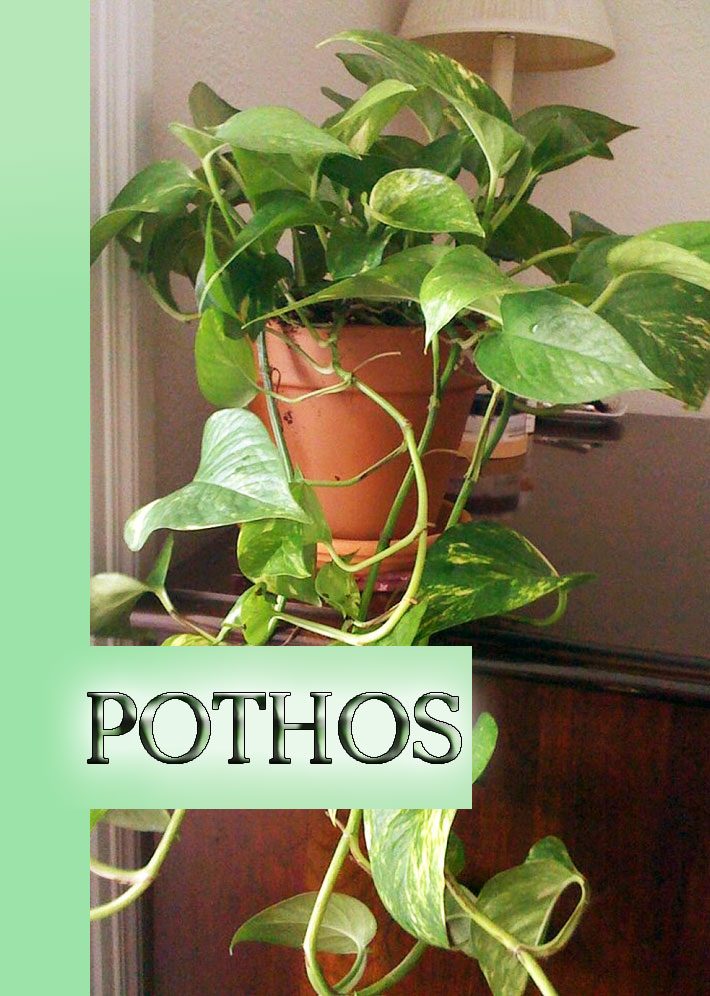
Pothos is arguably the easiest houseplant to grow. It’s a long-growing, leafy vine that can reach 40 feet or more in tropical jungles. It usually confines itself to about 6-10 feet in containers, but don’t be surprised if yours just keeps growing.
A perk of growing pothos is that they are high on the list of plants that can help purify indoor air.
- Foliage: Leaves are a pointed heart-shape and can be green or variegated in white, yellow or a paler green.
- Flowers: Pothos is rarely seen in flower. When it is found flowering, the flowers are white.
- Form: The natural form of pothos is a trailing vine. It can get very leggy if left unpruned. If allowed to dry out too drastically, the older leaves will yellow and wither, leaving the vine stripped at the base, with leaves only on the new growth. Pruning will keep the plant fuller.
Pothos vines will not cling to trellises and supports on their own, but they can be twined onto them and appear to grow upward.
Quick Facts
Botanical Name: Epipremnum aureum
Common Name(s): Pothos, Devil’s Ivy, Variegated Philodendron
USDA Hardiness Zones: Although pothos is perennial in USDA Hardiness Zones 10 and above, we most often see it grown as a houseplant.
Mature Size:
The size of the plant depends on the variety, how it is grown and how much it is pruned. Leaf size will also vary with variety and growing conditions. Mature plants grown in their native topical climates can reach 40 or more feet in length. Houseplants can easily reach 30 ft. Pruning stems as they get leggy makes for a bushier, more compact plant.
Exposure:
Outdoors, pothos can be grown in shade to partial shade. Indoors, pothos prefer bright but indirect light.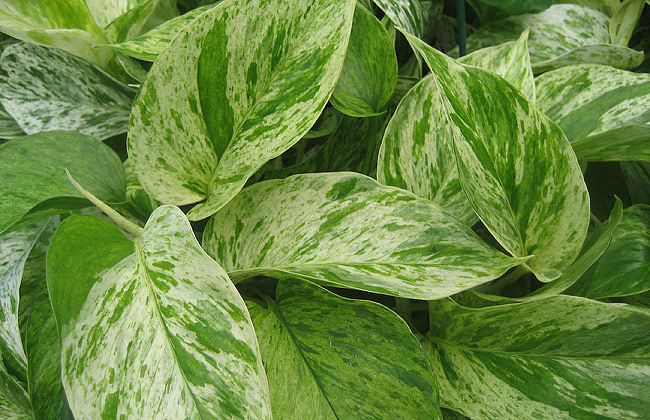
Bloom Period:
You will rarely see a pothos in flower, especially when grown indoors. However bloom period is mid-summer and the petal-less white flowers grow in spikes, covered with spathes.
Design Tips:
Pothos are perfect houseplants for areas that don’t get a lot of sunlight and for people who tend to forget to water their plants. They are an excellent plant for busy people, non-plant people, even for black-thumbs. And they’re an excellent choice plants for places like offices and dorm rooms.
If you do choose to let your pothos grown into a long vine, it can be secured on hooks along walls and over window frames, like the plant that took over Katherine Hepburn’s office in the movie “Desk Set”. Vines left to grow on their own can get very tangled, so shake them loose every now and then to keep them from becoming a mess.
You don’t have to limit your pothos plants to indoor growing. They can be used in containers and borders in the summer. They will die back with the first frost, but you can always bring them back indoors or simply take cuttings.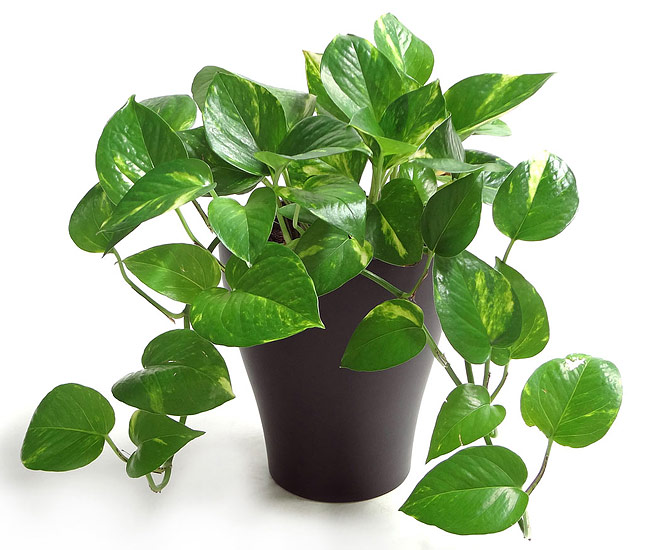
Pothos Suggested Varieties:
- ‘Marble Queen’ – A white-variegated variety that grows very slowly.
- ‘Golden’ – Leaves and stems have a yellow hue.
- ‘Tricolor’ – mottled with or yellow, cream and pale green. Harder to find.
Growing Tips:
Pothos are very easy care plants. They are tolerant of low light conditions and erratic watering. Your biggest chore will be keeping the vines from taking over.
Soil: Pothos prefer a slightly acidic soil, but any well-draining potting mix will suffice.
Water: Pothos like to have their soil dry out completely between waterings. If left continually in damp soil, the roots will rot. Let the plant tell you when to water. When it starts to droop, it needs a good drink. Don’t wait until the leaves start to shrivel or you will lose some leaves. Unlike the general rule of watering deeply and infrequently, I have found my pothos grow best if I give them a splash of water whenever they start to droop.
Fertilize: Pothos aren’t heavy feeders, but since there are no nutrients in most potting soils, feed monthly to bi-monthly, with any balanced houseplant fertilizer.
Pruning: No pruning is required, but it can be done to shape or control the size of your plant. Cut back to a leaf that is about 2 inches from the base of the plant, to keep new growth coming in.
Re-Potting: Eventually your pothos will become pot bound. When the leaves droop no matter how much or often you water them, the roots have probably filled the pot. Carefully lift the plant and check if that is the problem. When the plant has reached this stage, you can re-pot in a container 1 or 2 sizes larger, with fresh soil. It helps to trim the plant back at this time also. If you don’t want a larger plant, you can try dividing the plant or simply takes some cuttings and start over.
Propagating: Pothos are incredibly easy to root from cuttings. Simply put the cuttings in damp soil or even in a glass of water. I have had them growing over my compost heap, where I’d tossed out the excess. Move cuttings rooted in water into soil as soon as possible, so they can begin getting nutrients.
Pests and Problems: Pothos are usually pest free, but they can get infested with mealy bugs. Insecticidal soap works against them, but the easiest method is to simply dab them with an alcohol soaked cotton swab.
Most pothos problems are caused by poor growing conditions:
- Black spots on the leaves and the sudden collapse of the plant indicate the soil has been kept too wet.
- Dry, brown edges mean the plant was kept dry too long.
- Loss of variegation can mean the plant needs a bit more light.
- Suddenly paler looking leaves mean the plant is getting too much sun.
NOTE: All parts of the pothos plant are poisonous if ingested.
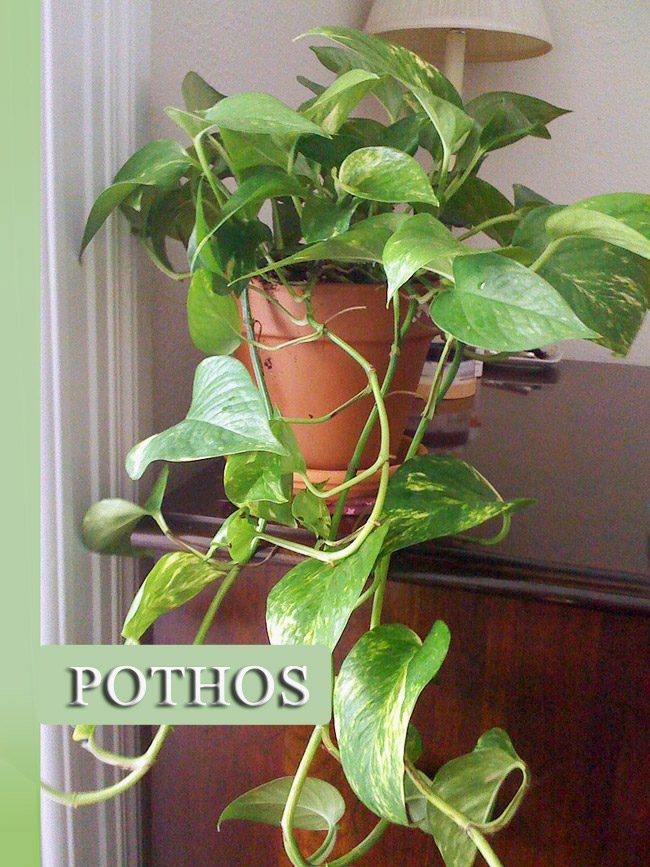

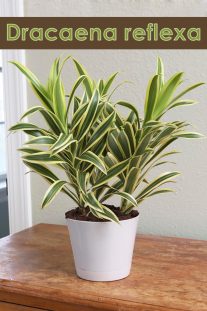

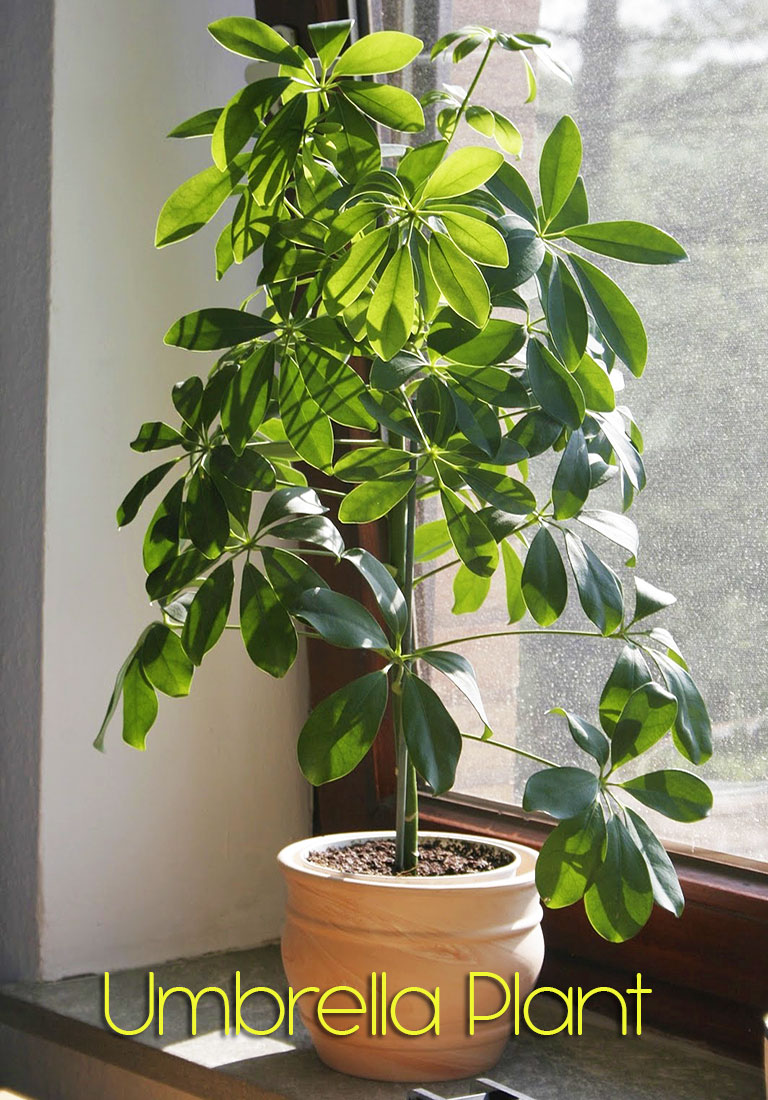
Leave a Reply